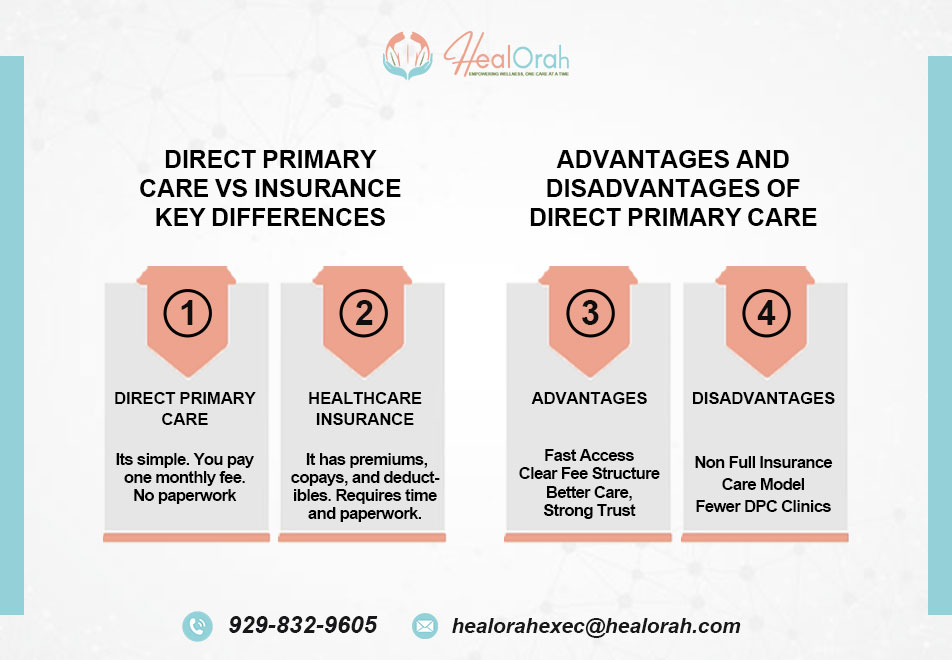Direct Primary Care (DPC) is a new approach to accessing healthcare services. It works like a monthly membership plan. People pay a flat monthly fee. This includes basic care, such as check-ups, lab tests, and doctor visits. The direct primary care model removes the need for health insurance. That means no co-pays and billing stress. Patients can contact their doctor by phone, text, or in-person visit at any time.
Table of Contents
ToggleThis gives more personal care. The cost stays the same every month. It’s simple. Many people use direct primary care insurance as an additional coverage option, such as for surgery and hospital stays.
Moreover, this care model is experiencing rapid growth. It helps people save money and time. It also builds trust between doctors and patients. DPC is great for families, workers, and small business owners. It is easy, direct, and built around the patient.
How the Direct Primary Care Model Works: Fees & Services
The direct primary care model is straightforward to understand. Patients pay a monthly fee to their doctor. This fee covers most basic health care needs. There is no need for health insurance for visits. You can see your doctor as often as needed. No co-pays and surprise bills are involved.
A direct primary care practice offers Services that include check-ups, lab tests, and urgent care. Some plans also offer virtual visits. It helps people save money in the long run. This model gives more time with the doctor. Care is personal, straightforward, and stress-free. Many families now prefer this care option for everyday health needs.
Direct Primary Care vs Insurance: Key Differences
Some people use direct primary care. Others use health insurance. But they work in different ways. Let’s see how they differ.
Direct Primary Care
Direct Primary Care is simple. You pay one monthly fee. No bills. No surprise costs. With DPC, you talk to your doctor fast. No waiting. Also, DPC doctors see fewer patients. That means more time with you. It’s best for everyday care and easy visits. You do not need to deal with paperwork or approval delays.
Traditional Health Insurance
Health insurance has premiums, copays, and deductibles. It often requires time and additional paperwork. Doctors see many patients, so you get less time per visit. Insurance helps in emergencies or significant medical needs. It does not replace DPC but can work beside it. Choose what fits your health needs and your budget.

Advantages and Disadvantages of Direct Primary Care
Direct Primary Care is a straightforward way to access healthcare. You pay a fixed monthly fee. It helps you stay healthy without surprise costs. But, like all things, there are advantages and disadvantages of direct primary care that you should consider before choosing this model.
Advantages of Direct Primary Care
Direct Primary Care gives fast access to your doctor. You do not need to wait for hours. Patients can call, text, or visit when they need to. Monthly fees are clear and straightforward. Most plans include basic tests and visits. Doctors have fewer patients, allowing them to spend more time with each one. This means better care and strong trust. No co-pays or surprise bills also help many families save money.
Disadvantages of Direct Primary Care
This care model is not full insurance. It doesn’t cover hospitals or significant health issues. You may still need other coverage. Some people may pay twice, once for DPC and again for insurance. Also, not every place has DPC clinics. If you travel frequently, it may not work well. And if you rarely visit doctors, the monthly fee may feel like a waste.
Direct Primary Care Cost: Monthly Rates & Savings
Most DPC clinics charge between $55 and $150 per month. The direct primary care cost often becomes more affordable through family or bundled group plans. This cost includes visits, basic laboratory tests, and additional services. It may ultimately save money.
You avoid co-pays and surprise bills. Plus, many feel better with personal care. However, DPC may cost more if you rarely visit the doctor and still pay for insurance. Think about your health needs. For regular care and peace of mind, it might be worth it.
Direct Primary Care Advantages: Is It Right for You?
Direct Primary Care (DPC) provides straightforward and transparent health services. You pay a flat monthly fee with no surprise bills and hidden charges. It’s ideal for families, small business owners, and individuals with chronic health issues. You get more time with your doctor, and there’s no rush.
Care feels personal and stress-free. Unlike insurance, you do not deal with claim forms. If you’re searching for direct primary care near you, this model offers easy access, fewer ER visits, and greater control. Consider your needs and determine if DPC aligns with your lifestyle.
Why Choose Heal Orah for Direct Primary Care
Heal Orah puts your health first. You get personal care without long waits. Each plan is simple and easy to follow. You pay one low monthly fee, with no surprise bills. The doctors take time to listen. You feel seen and supported every step of the way. From check-ups to care plans, it’s all straightforward and stress-free.
Many families trust Heal Orah for their daily health needs. It’s care that fits your life, not the other way around. Choose comfort, trust, and peace of mind all in one place. Book a consultation with Heal Orah to create your personalized stress-relief plan.
Conclusion
Direct Primary Care is a straightforward way to access healthcare without using insurance. It offers easy access to doctors and transparent monthly fees. This model helps patients save money while getting personal care. However, it may not cover emergency or specialist services.
Still, it works well for routine visits and long-term care. Costs usually range from $50 to $100 per month. If you’re looking for care that is easy, direct, and affordable, this could be the right fit. To get started with trusted care, explore Heal Orah, a service designed to make your health stress-free and straightforward.
FAQS
Q. What is Direct Primary Care?
Direct Primary Care is a monthly membership-based healthcare model that eliminates the need for insurance. It includes unlimited visits, basic tests, and direct access to doctors.
Q. How is Direct Primary Care different from concierge care?
DPC has lower fees and does not bill insurance. Concierge care is more expensive and often involves insurance billing.
Q. What are the pros and cons of Direct Primary Care?
Pros include same-day access and no copays. Cons are limited specialist care and the need for separate insurance.
Q. Is health insurance still required with Direct Primary Care?
Yes, DPC covers only primary care and doesn’t include specialists or emergencies. Pairing it with a high-deductible or catastrophic plan is advised.
Q. Typical Membership Fee for Direct Primary Care?
Memberships usually range from $50 to $150 per month. This flat rate usually covers routine visits and fundamental laboratory tests.





